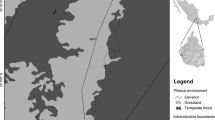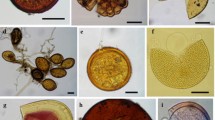Abstract
Response of Theobroma cacao L. (cacao) and the shade tree Inga edulis Mart. (inga) seedlings from an organically-grown cacao plantation to inoculation with native arbuscular mycorrhizae forming fungi (AMF) was studied in a cross-inoculation assay under greenhouse conditions. Seedlings of inga and cacao were grown in pots filled with heat-treated soil from the plantation. Control was heat-treated soil without inoculum and roots of cacao and inga from the plantation were applied as AMF inocula. Undisturbed soil blocks were used as a “positive control” of the inoculation potential of untreated soil and roots combined. No AMF structures were observed in the roots of either species in the heat-treated control. All inocula were infective in both hosts and the differences in the total AMF colonization percentage between the hosts were not significant but inga had significantly higher colonization by hyphal coils and arbuscules. Cacao roots but neither inga roots nor soil block inocula stimulated cacao growth. All inocula significantly increased growth of inga, which had higher relative mycorrhizal responsiveness than cacao. Thus, in spite of the strong infectivity of the inocula in both hosts, cacao and inga responded differently to the same AMF populations. The strong conspecific preference of cacao suggests that attention must be paid to the AMF inoculum used for this species. However, the strong response of inga to cacao root inoculum indicates that the two species may share same AMF symbionts, thus enabling positive interactions between them, including formation of common mycelial networks.



Similar content being viewed by others
References
Bâ AM, Plenchette C, Danthu P, Duponnois R, Guissou T (2000) Functional compatibility of two arbuscular mycorrhizae with thirteen fruit trees in Senegal. Agrofor Syst 50:95–105
Beer J, Muschler R, Kass D, Somarriba E (1998) Shade management in coffee and cacao plantations. Agrofor Syst 38:139–164
Croll D, Giovannetti M, Koch AM, Sbrana C, Ehinger M, Lammers PJ, Sanders IR (2009) Nonself vegetative fusion and genetic exchange in the arbuscular mycorrhizal fungus Glomus intraradices. New Phytol 181:924–937
Dhillion SS (1992) Evidence for host-mycorrhizal preference in native grassland species. Mycol Res 96:359–362
Dickson S, Smith FA, Smith SE (2007) Structural differences in arbuscular mycorrhizal symbioses: more than 100 years after Gallaud, where next? Mycorrhiza 17:375–393
Diop TA, Krasova-Wade T, Diallo A, Diouf M, Gueye M (2003) Solanum cultivar responses to arbuscular mycorrhizal fungi: growth and mineral status. Afr J Biotechnol 2:429–433
Giovannetti M, Avio L, Fortuna P, Pellegrino E, Sbrana C, Strani P (2006) At the root of the wood wide web: self recognition and non-self incompatibility in mycorrhizal networks. Plant Signal Behav 1:1–5
He X-H, Critchley C, Bledsoe C (2003) Nitrogen transfer within and between plants via common mycorrhizal networks (CMNs). Crit Rev Plant Sci 22:531–567
Hoeksema JD, Chaudhary VB, Gehring CA, Johnson NC, Karst J, Koide RT, Pringle A, Zabinski C, Bever JD, Moore JC, Wilson GWT, Klironomos JN, Umbanhowar J (2010) A meta-analysis of context-dependency in plant response to inoculation with mycorrhizal fungi. Ecol Lett 13:394–407
Ingleby K, Wilson J, Munro RC, Cavers S (2007) Mycorrhizas in agroforestry: spread and sharing of arbuscular mycorrhizal fungi between trees and crops: complementary use of molecular and microscopic approaches. Plant Soil 294:125–136
Jansa J, Smith FA, Smith SE (2008) Are there benefits of simultaneous root colonization by different arbuscular mycorrhizal fungi? New Phytol 177:779–789
Kiers ET, Lovelock CE, Krueger EL, Herre EA (2000) Differential effects of tropical arbuscular mycorrhizal fungal inocula on root colonization and tree seedling growth: implications for tropical forest diversity. Ecol Lett 3:106–113
Koide RT, Li M (1989) Appropriate controls for vesicular arbuscular mycorrhiza research. New Phytol 111:35–44
Kuyper TW, Cardoso IM, Onguene NA, Murniati, van Noordwijk M (2004) Managing mycorrhiza in tropical multispecies agroecosystems. In: van Noordwijk M, Cadisch G, Ong CK (eds) Below-ground interactions in tropical agroecosystems. CABI Publishing, Wallingford, UK, pp 243–261
Lawrence A (1995) Farmer knowledge and use of Inga species. In: Evans DO, Szott LT (eds) Nitrogen fixing trees for acid soils. Nitrogen Fixing Tree Res Rep, Spec Iss 1995, pp 142–151
Lovelock CE, Ewel JJ (2005) Links between tree species, symbiotic fungal diversity and ecosystem functioning in simplified tropical ecosystems. New Phytol 167:219–228
McGonigle TP, Millar MH, Evans DG, Fairchild GL, Swan JA (1990) A new method which gives an objective measure of colonization of roots by vesicular-arbuscular mycorrhizal fungi. New Phytol 115:495–501
Mogollón Frasca BA (2007) Efecto de la disponibilidad de nitrato y amonio, en la distribución de raíces en un sistema agroforestal. Proyecto de Graduación, Universidad EARTH, Guácimo, Costa Rica, p 26
Nygren P, Leblanc HA (2009) Natural abundance of 15N in two cacao plantations with legume and non-legume shade trees. Agrofor Syst 76:303–315
Phillips JM, Hayman DS (1970) Improved procedures for clearing roots and staining parasitic and vesicular-arbuscular mycorrhizal fungi for rapid assessment of infection. Trans Brit Mycol Soc 55:158–161
Plenchette C, Fortin JA, Furlan V (1983) Growth responses of several plant species to mycorrhizae in a soil of moderate P-fertility. I. Mycorrhiza dependency under field conditions. Plant Soil 70:199–209
Ravnskov S, Jakobsen I (1995) Functional compatibility in arbuscular mycorrhizas measured as hyphal P Transport to the plant. New Phytol 129:611–618
Rosendahl S (2008) Communities, populations and individuals of arbuscular mycorrhizal fungi. New Phytol 178:253–266
Ruiz-Lozano JM (2003) Arbuscular mycorrhizal symbiosis and alleviation of osmotic stress. New perspectives for molecular studies. Mycorrhiza 13:309–317
Sanders IR, Koide RT, Shumway DL (1999) Diversity and structure in natural communities: the role of the mycorrhizal symbiosis. In: Varma A, Hock B (eds) Mycorrhiza: structure, function, molecular biology and biotechnology, 2nd edn. Springer-Verlag, Berlin, Germany, pp 571–593
Schenck NC, Pérez Y (eds) (1990) Manual for the identification of VA mycorrhizal fungi, 3rd edn. Synergistic Publications, Gainesville, FL, USA, p 286
Schüssler A, Schwartzott D, Walker C (2001) A new fungal phylum, the Glomeromycota: phylogeny and evolution. Mycol Res 105:1413–1421
Smith FA, Smith SE (1997) Tansley Review No. 96. Structural diversity in (vesicular)-arbuscular mycorrhizal symbioses. New Phytol 137:373–388
Acknowledgments
We thank the staff of the Academic Farm of the EARTH University for daily maintenance of the greenhouse experiment. The study was financed by the Academy of Finland (grant 111796) and the EARTH University Research Committee.
Author information
Authors and Affiliations
Corresponding author
Rights and permissions
About this article
Cite this article
Iglesias, L., Salas, E., Leblanc, H.A. et al. Response of Theobroma cacao and Inga edulis seedlings to cross-inoculated populations of arbuscular mycorrhizal fungi. Agroforest Syst 83, 63–73 (2011). https://doi.org/10.1007/s10457-011-9400-9
Received:
Accepted:
Published:
Issue Date:
DOI: https://doi.org/10.1007/s10457-011-9400-9




